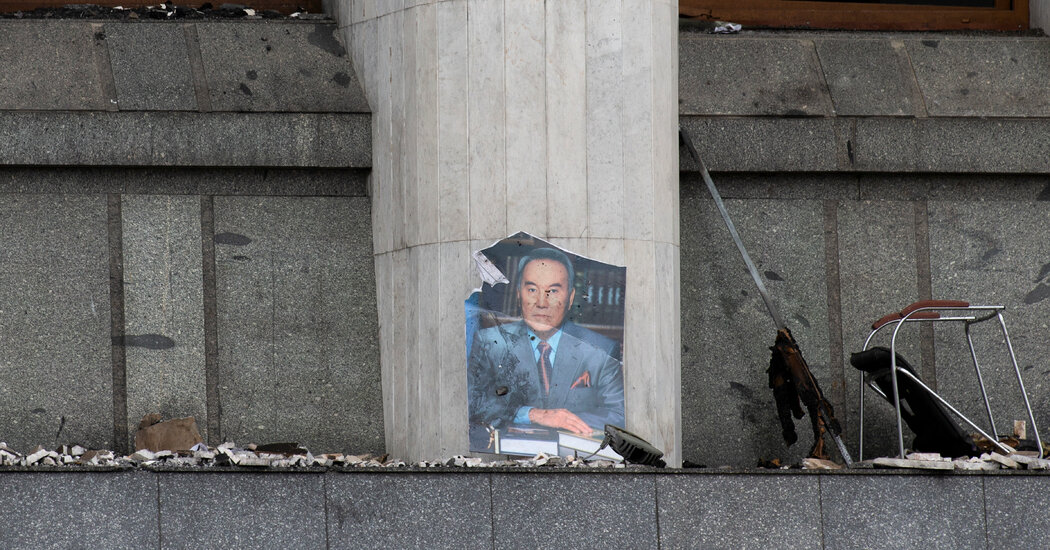Nursultan Nazarbayev, who had been absent during the recent unrest that gripped the country, said he supported the country’s leader and the economic reforms he has proposed.
NUR-SULTAN, Kazakhstan — Kazakhstan’s long-serving former president, who was conspicuously absent during the unrest that rocked the country this month, posted a video on Tuesday with his first public comments since the violence erupted, saying he supported the country’s leader and the economic reforms he has proposed.
In the video address, Nursultan Nazarbayev, who ruled the Central Asian nation for three decades before stepping down, described the unrest — the worst the country had seen since declaring independence from the Soviet Union in 1991 — as an assault on Kazakhstan.
“The purpose of these organized riots and attacks on Kazakhstan was to destroy the integrity of the country and the foundations of the state,” he said in the video, delivered in Kazakh and Russian on his website.
The absence of Mr. Nazarbayev, 81, from Kazakhstan’s political scene fueled speculation that he and his family members had left the country. In his address, he said he was inside Kazakhstan, but gave no evidence for his claim.
Mr. Nazarbayev began ruling the country in 1989 and stepped down in 2019, paving the way for his handpicked successor, Kassym-Jomart Tokayev. However, he is widely believed to have wielded power and influence under a 2010 law that named him “leader of the nation” and gave him a lifetime appointment at the head of the country’s powerful Security Council. He also remained the leader of the ruling Nur Otan party.
Mr. Nazarbayev, who is widely seen as having presided over a system of cronyism and corruption in Kazakhstan that enriched just a handful of rich businessmen, and his family were key targets of the protesters. A cry of “Shal Ket!” or “Old Man, Out,” directed at Mr. Nazarbayev, quickly became one of the catchphrases of the protests, which began in the west of the oil-rich country over a significant increase in fuel prices.
The absence of Mr. Nazarbayev, who had last been seen in public in late December, also fueled speculation that there had been a rupture between him and Mr. Tokayev. That was exacerbated by comments Mr. Tokayev made appearing to blame his predecessor for the country’s corruption-ridden economy that many experts feel helped trigger the unrest.
Mr. Nazarbayev insisted in the video address that he had relinquished formal and informal powers in 2019, saying he was now a simple “pensioner.”
But despite that assertion, Arkady Dubnov, an expert on Kazakhstan and other Central Asian countries, said that Mr. Nazarbayev continued to exert influence within the government beyond 2019.
Mr. Nazarbayev’s belated appearance most likely meant that various factions in the government had made a deal and that he had agreed to “give up” influential members of his family, Mr. Dubnov said.
Since the unrest, a number of officials related to Mr. Nazarbayev have been removed from their posts, including his son-in-law as head of the national oil transport company; his nephew at the main security service; and another son-in-law as chief of a chamber of trade.
Mr. Nazarbayev also hailed a raft of reforms announced by Mr. Tokayev focused on addressing income inequality and corruption. “The president put forward a new reform program aimed at improving the welfare of the people,” he said. “This program needs to be supported.”
Understand the Protests in Kazakhstan
What’s happening? Protests in Kazakhstan incited by anger over surging fuel prices have intensified into deadly clashes over the future direction of the autocratic Central Asian country. Here’s what to know about how the protests started and why they matter:
Mr. Tokayev replaced Mr. Nazarbayev as chair of the Security Council on Jan. 5, as the violent clashes peaked in Kazakhstan’s largest city, Almaty. He also ousted officials, described by experts as Mr. Nazarbayev’s allies, from the top positions in the National Security Committee, the successor to the K.G.B.
In his video address, Mr. Nazarbayev sought to quash rumors that the violence was the result of a power struggle within the country’s elite, saying that Mr. Tokayev now has “full power.” He also said that Mr. Tokayev would soon take over as head of the Nur Otan party.
On Saturday, prosecutors said that 225 people had been killed in the violence, and more than 4,000 injured. The unrest was eventually quelled after Mr. Tokayev appealed for “peacekeepers” from a Russian-led military alliance of former Soviet nations.
Daniil Kislov, an expert on Central Asia and founder of the Ferghana, a website that covers the region, said Mr. Nazarbayev’s speech put forward a “rather chaotic” set of arguments that obstructed the truth about the ultimate cause of the violence that struck Kazakhstan in the first week of January.
“Nobody is able to tell the truth,” he wrote on his Facebook page. “The simulation of public policy against the backdrop of the fiercest undercover squabbling for resources continues.”
Ivan Nechepurenko contributed reporting from Moscow.


























